 with a few bits by
with a few bits by 
Vienna: City of Mozart
Our train pulled into Meidling station mid-afternoon. This was a temporary arrangement while the usual station (Südbahnhof) was closed for renovations, so it was a bit confusing at first (all the tourist info sites/books listed directions to downtown Vienna from Südbahnhof). As it turned out, it was far easier from Meidling, since it’s right on the U-bahn (subway) line; not just the S-bahn (train) lines. A few U-bahn stops later and we arrived at Karlsplatz station, right on the Ringstraße (a major road that forms a ring around the inner core of Vienna). Turns out it has several exits and we took the one that gave us a more, uh, scenic route to our destination.
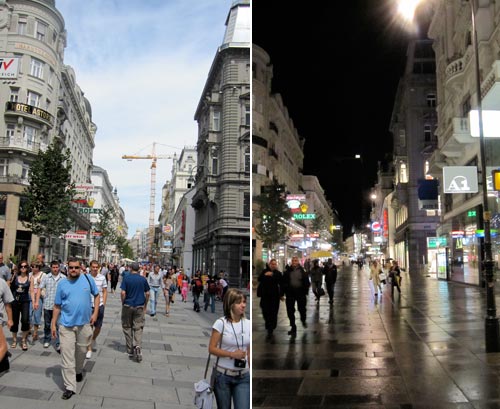
Kärntnerstraße, the main pedestrian mall of the Innere Stadt by day and night.
Our hotel, Opera Suites was about as central as you can get to downtown Vienna, right on the main pedestrian mall on Kärntnerstraße. Loads of chi-chi boutiques and restaurants (regrettably, mainly the usual multinationals that pop up in every city: Prada, Starbucks, Hugo Boss, Swarovski Crystal, etc., etc…what the hell is the big attraction about Swarovski crystals?!), with signs piled on top of each other up and down the fronts of the beautiful buildings. Peter called it Vienna’s Ginza. Steps away: the Vienna State Opera; Imperial Palace; and many, many museums and historic buildings. Lots of impressive architecture here, too (with its share of filigree, but not the overwhelming quantity of Prague), but the city (and especially its civic buildings) is definitely built on a grander scale than Prague.
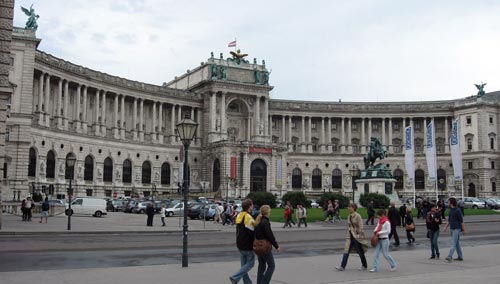
Example of Vienna’s grand scale: Austrian National Library. Click photo for a large panorama of the surroundings.
One of the main icons of the city, whose face was plastered everywhere (except where there were George Clooney Nespresso ads), was Mozart. Wolfie’s mug was used to advertise just about everything, but especially chocolate and candy. We even bought a Mozart PEZ dispenser for Jon.
The hotel was a small walk-up (we had to get buzzed in by the front desk, three flights up), featuring the world’s smallest elevator: Two people with carry-on bags could barely squish in. Since it was also slug-slow, we never bothered using it again, much preferring the old-fashioned stone stairs. Our room also looked old-fashioned, with very tall ceilings and windows, and pleasantly heavy furniture and decor. The bathroom was small (no tub, unlike at the Red and Blue) but modern and clean. Our windows faced a ventilation unit and another building, away from Kärntnerstraße, so our view was nonexistent; the blissful lack of street noise compensated.
Museums and Palaces and Strauss, oh my!
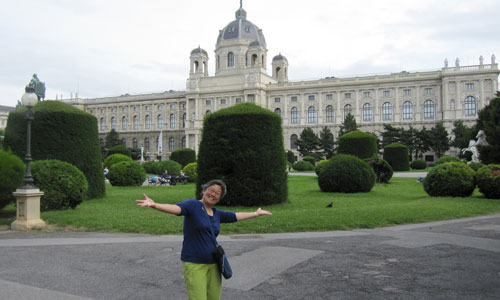
The first full day in Vienna we explored the Naturhistorisches Museum (Natural History Museum). An impressively beautiful museum from the 1880s, with staggeringly large collections of precious stones and minerals, meteorites and prehistoric artifacts (including the one notable piece: the Venus of Willendorf). The rocks and meteorites were very prettily mounted in huge, wooden cabinets; but there were so many of them that after awhile your eyes start glazing over. The whole second floor was filled with stuffed and mounted representatives of animal species from microscopic forms to the great apes. Most of the stuffed animals are well over 100 years old (a few are over 200), and look it; bird feathers were often a bit faded, and mammals’ fur sometimes looked a bit mangy. The museum itself seemed a bit encased in amber—a handsome snapshot of a Victorian-era museum, and this position hasn’t changed much in the intervening 130 years.
Some parts of the building seemed to reveal a cultural chauvinism, carved in stone. While the Art History Museum across the way featured these two (Painting and Sculpture) flanking the doors:
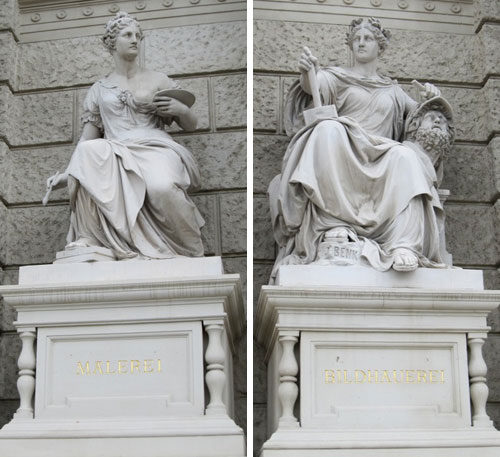
…the Natural History Museum featured this pairing:
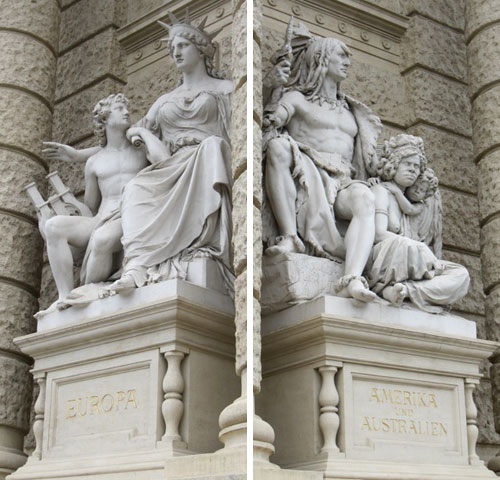
Let’s go inside…
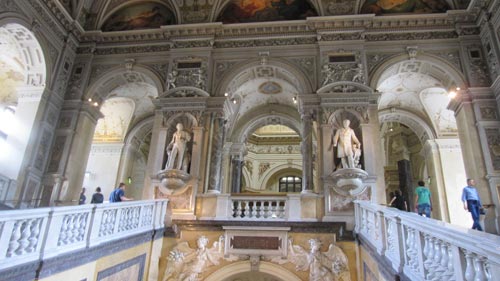
Ornate central stairs at Natural History Museum. The building was just as impressive as the exhibits. [Click photo for a panorama]
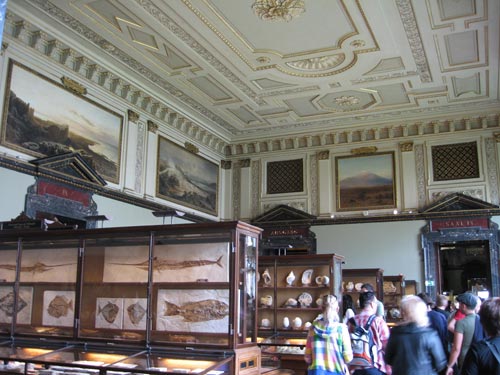
Some of the Natural History Museum’s displays. There were many, many rooms like this. Rooms and rooms.
A more modern temporary exhibit was “Darwins rEvolution”. Most of it was in German only, so we skipped past a lot of the displays. Major informational posters were in English as well, though, and we noted with satisfaction the uncompromising stance the museum was taking regarding evolution vs. creationism. I don’t think any North American museum would have the guts to draw such a firm line against the anti-evolutionists; museums here would be a lot more mealy-mouthed and conciliatory in their conclusions.
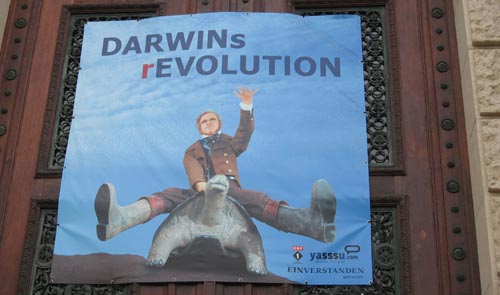
Having fun with Darwin.
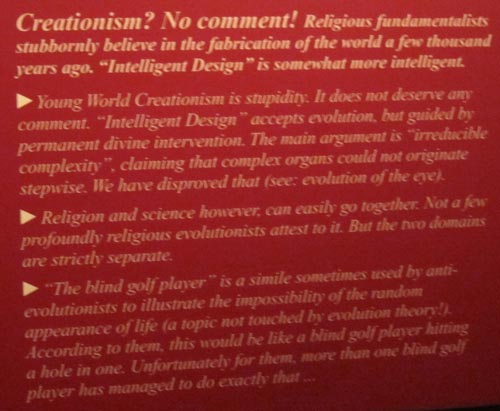
The concluding text about evolution vs creationism. Oooh, snap!
In both Prague and Vienna tourists are besieged by sellers (in Vienna they were in period costume—or evening dresses for the lady hawkers) hawking tickets to classical concerts in various venues. We finally succumbed in Vienna, aided by the fact that the Schönbrunn Palace Orchestra‘s concert was playing in the Great Gallery at Schönbrunn Palace, which is a bit grander than their usual palace venue, the Orangerie. The trip to Schönbrunn was made more eventful by our subway train’s emergency stoppage (from the way the officials and emergency crews acted, we’re guessing that someone jumped in front of our train). We kept moving, walked two stations down the line, and grabbed a couple of buses in succession with the help of three Viennese men who didn’t know each other and had not a stick of English. But they made sure we got where we needed to go! Tausend Dank, gents!
The large ensemble and two singers performed popular Mozart and Strauss pieces in the gorgeous Great Gallery. Very greatest-hits stuff, but very well played—the singers in particular (good singers and good performers too), seemed to be having a great time. Unlike the concertmistress, who looked like she’d swallowed a lemon during the whole performance. Amusingly, the audience seemed to be roughly divided up into Mozart-lovers (like us) and Strauss-lovers (like the couple next to me) who were alternately bored or delighted, depending on what was being played.
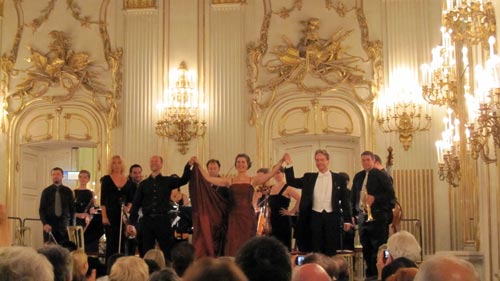
Concert in the Schönbrunn’s Great Gallery: The only time we were allowed to take photos inside the palace.
Schnitzel oder Strudel? Nein.
At first, like Prague, we intended to partake often of the Viennese cuisine. But the first night, hungry after our trip, we found an Italian restaurant on Kärntnerstraße and had some nice pasta. The second night, we sought out weiner schnitzel at Pfudl, a decent-enough restaurant. The thing is, it’s weiner schnitzel. Just like here. Nicely cooked, more authentic presentation with the pickled salad, but essentially, it’s breaded veal. At this point in our trip we were getting a bit meated-out, and were craving veggies badly. Also, the range of Viennese food was narrower than that of even Prague, and it was obviously that post-war Vienna had dealt with that by adopting dishes from other countries. Pasta, pizza, sushi, kebabs, you name it.
On the dessert front, when we had made our decision to visit Vienna, I was pleased because I would finally accomplish my goal of eating the perfect apple strudel. I had always held in my head a Platonic ideal of a great Apfelstrudel, but had never managed to experience one in Toronto (they never seemed to have enough filling for my taste). Now was my chance! During our Vienna stay I had two apple strudels, and they were excellent examples, and very similar to each other: flaky pastry (but not too much of it) with tons of apple and raisin filling and much cinnamon. We even saw a demonstration of how they are made, and it’s a complex enough procedure that I’m probably not going to attempt it anytime soon.
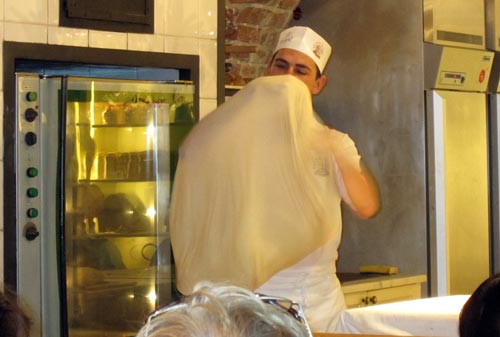
The apple strudel show at Schönbrunn Palace (chronologically I’m getting ahead of myself here).
But after ingesting a few pieces of pastry, to my shock and disappointment I realized that I don’t much care for apple strudels! Peter was likewise disappointed when he tried the sachertorte (at the famed Sacher Café, no less, where the famed cake originated) After that, given the choice of whether to have a cake/pastry or gelato for dessert, ice cream won every time. This was helped by the presence of Zanoni & Zanoni, gelateria extraordinare! Absolutely humungous (and delicious) dollops, slabbed atop cones, for the measly price of € 2.50 each (less than $4 Cdn). We ended up having gelato every day of our stay.
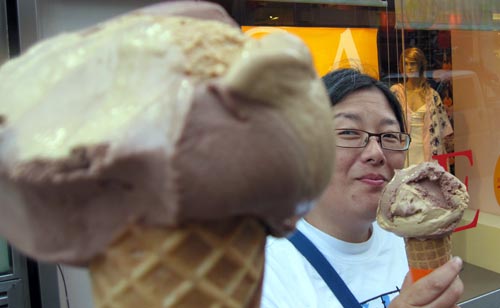
Ice cream as big as your head?! One of our daily gelatos at Zanoni’s.
I was a bit disappointed that we never found the time to go to a real, traditional Vienna Kaffeehaus, so I wasn’t able to compare top-notch cappuccino with what we get here. We did go to the high-end touristy Café Mozart (whose patio was featured in the movie The Third Man), and the coffee was okay, but nothing spectacular for the price. I also had coffees at Le Bol, a French café (which I’ll talk more about below), but that didn’t really count as a Kaffeehaus because it was French (even if they did serve the water palate-cleanser.)
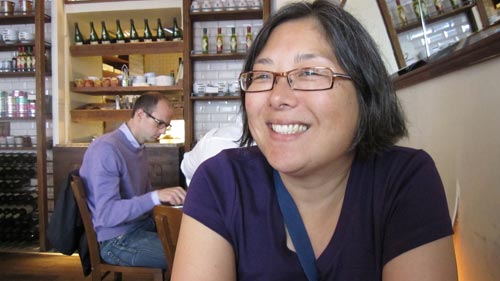
Le Bol, where we ate a couple of very tasty breakfasts. Our French is marginal, but it’s miles better than our German!
Schönbrunn Palace & Sisimania
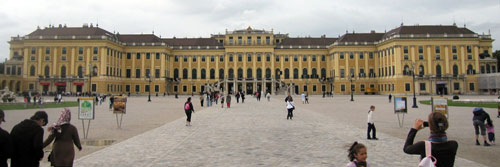
The front of Schönbrunn Palace
On Day 2 we headed again to Schönbrunn for a more in-depth visit. A lot more tourists this time; we had to cool our heels in the gardens for an hour while we waited for our palace admission time. The driving force behind the design and construction of this palatial summer home of the Austrian Hapsburgs was the Empress Maria Theresia, an energetic sort who also managed to have 16 children while ruling the empire (and getting kissed by just-finished-his-performance, 7-year-old Wolfgang Mozart).
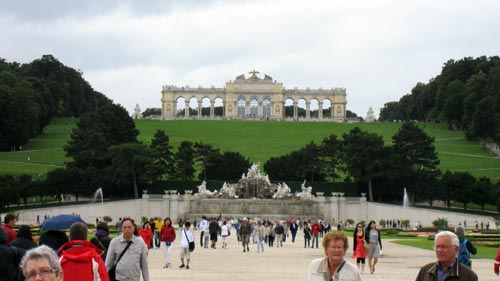
Impressive view of palace grounds. The building at the top of the hill is the Gloriette. Click photo for a panorama. Here’s another in the rain.
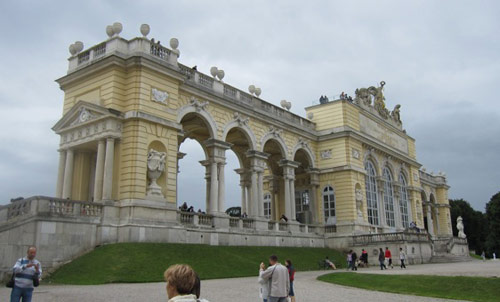
As we got closer, I realized: It’s a bloody gazebo!
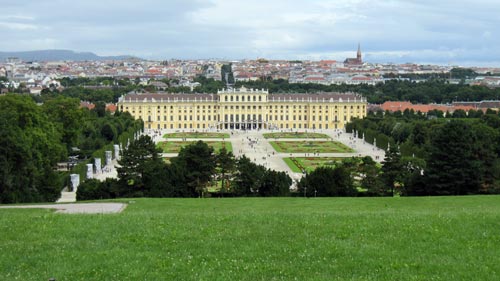
The view of the palace from the gazebo Gloriette. This was the Hapsburgs’ summer home, and as such was manned by a skeleton staff of 1,500. Click photo for a panorama.
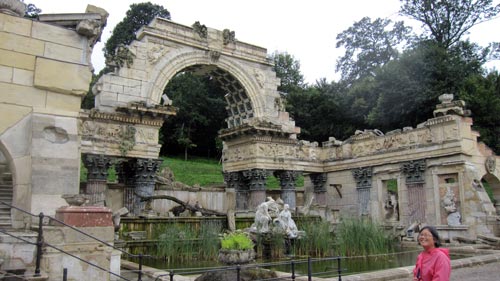
At times the Hapsburgs came across as nouveau riche: This folly wouldn’t have looked out of place at Disney World.
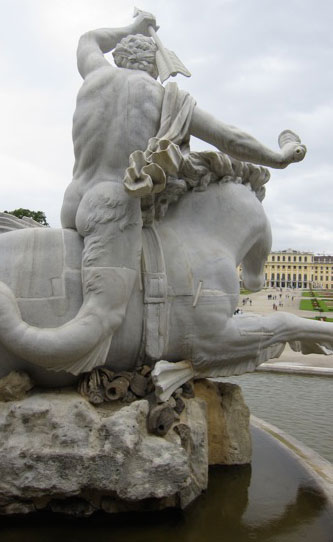
Other statuary looked impressive from far away, but close-up you could see where they cheaped out in their construction, relative to other European landmarks. Note the assembly seams and joins. (I know, pick, pick, pick!)
Once inside we weren’t allowed to take photos, so we were glad we went to the concert the evening before! But all throughout you could see where the emperors were trying to make their own Versailles—conspicuous consumption galore and very costly room finishes. One room was even called the “Millions Room” because of its cost, and involves priceless Persian artwork cut up out of their original context to be fit into hundreds of individually-carved cartouches on the rosewood walls. [Headslap!] It was kind of amazing that the imperial family was never overthrown by enraged commoners, and in fact survived until the 20th century.
Once of the most popular royals was the Empress Elizabeth, better known as “Sisi”. She was a beautiful, Princess Diana-like figure who married into the imperial family in the mid-Victorian era. As she hated royal life, she rarely stayed in either of the imperial residences (preferring to take endless cruises around the world.) Despite that inconvenient fact, Sisi’s lovely face is plastered all over items in the palace gift shop. And that goes for Vienna souvenirs in general, too—basically if your souvenir has a face, it’s either Wolfgang’s or Sisi’s.
That evening we toured the Naschtmarkt, the farmers’ market, saw rows and rows of beautiful vegetables, and wondered why we hadn’t gotten many in the restaurants. We ate at a fish restaurant at the market, and had a delicious seafood platter for two—with absolutely no veggies. Psst, waiter, look out the window!!
Potpourri: Riesenrad, Staatsoper and Kunsthistorisches Museum
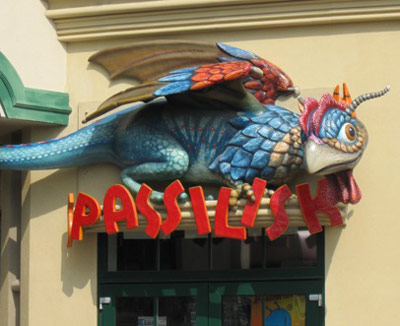
The Prater park Basilisk mascot
On our last full day in Vienna we managed to cram in a variety of sights: Prater Park, with the Riesenrad, a ferris wheel dating from 1897. The Riesenrad (another place featured in The Third Man) was so deliciously touristy, we just had to ride it. Each car is basically a box hanging from a fulcrum, and it rocked entertainingly when the French family sharing our car ran from one side to the other, listing something on the order of 10°.
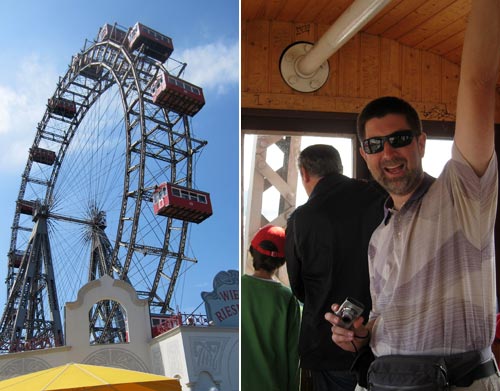
Riesenrad. When the ride was reconstructed after the war they only replaced half the number of cars. Looks better that way. Right: Peter inside the car.
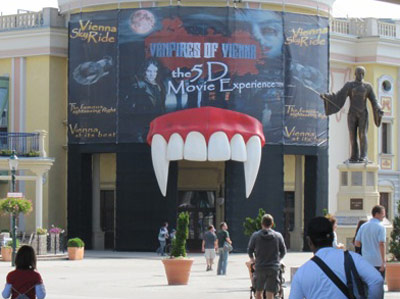
We didn’t go on this, but we bet that it’s at least two dimensions better than a mere 3D experience!
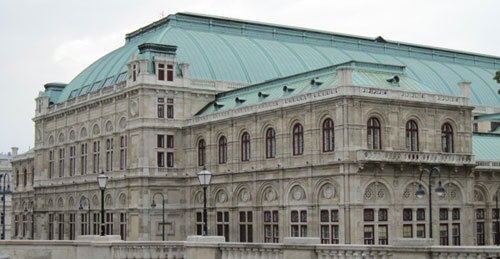
The Wiener Staatsoper.
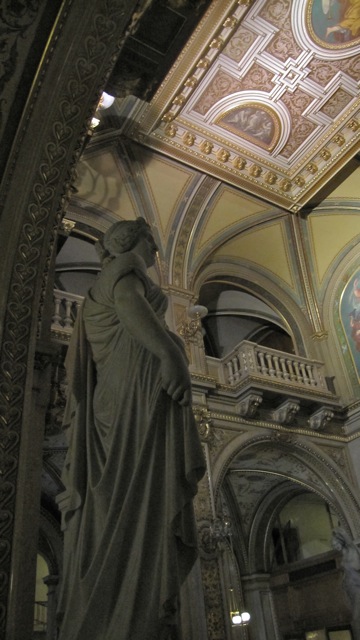
The lobby.
Back to higher-brow pursuits, the Wiener Staatsoper (Vienna State Opera) is a building with a split personality because of damage to it from World War II. The whole front lobby is original from the 1860s, and is ornately Victorian; in contrast the auditorium and waiting room date from the minimalist 1950s, and the effect is a bit jarring.
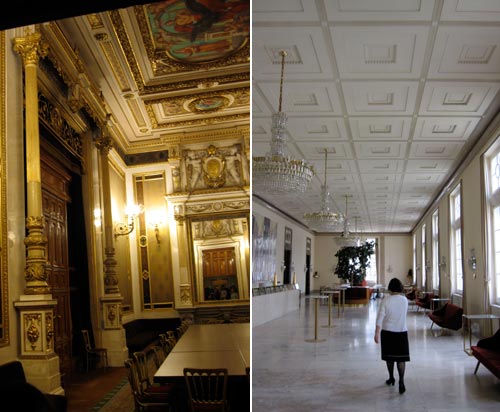
Staatsoper old and new: Imperial tea room (where the Emperor would go between acts); Marble Hall (where the audience goes between acts.)
During our tour, we were informed that the budget of the Opera is € 100 million, of which the Austrian government subsidizes € 55 million. (Can you imagine if our current federal government supported the arts to anywhere near that amount!) And it truly lives up to its goal of being the people’s opera house: Of the 2,500 seats in the house, about 500 of them are standing-room seats, costing a measly € 3 or € 4.
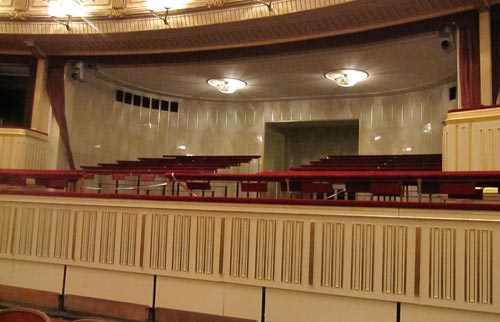
Top-price (€ 4) standing-room stalls. They are directly below the royal box, so they’re pretty good seats!
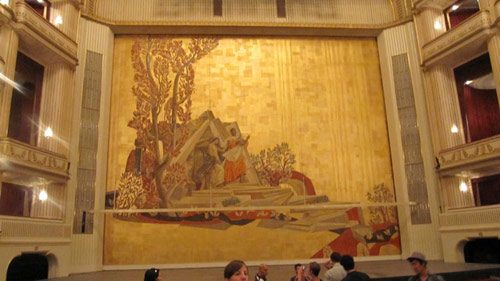
The curtain, featuring 50’s art portraying the (Austrian-written) opera Orfeo ed Euridice
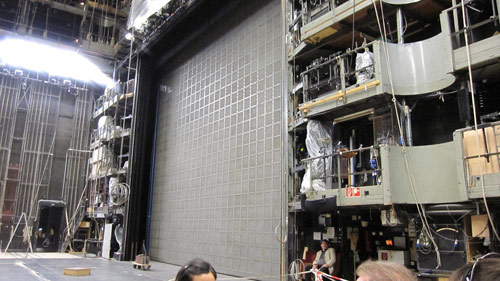
Behind the scenes. There’s something like 100 bays for backdrops and scrims, as they have many operas going at one time during the season!
Our last big touristy cultural site was the Kunsthistorisches Museum (Art History Museum), which is a mirror-image building to the Natural History Museum on either side of a square named for Maria Theresia. Having been warned that the gallery’s collection is extensive (if limited to pre-1850), we decided to pick and choose our rooms, drifting through others quickly unless something caught our eye. We focused on the works of Bruegel, Holbein and Dürer and lapped it up.
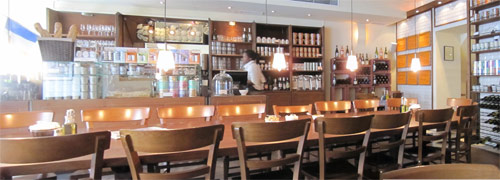
Le Bol
In our quest for a decent breakfast earlier that morning (everything opens later on Sunday), we came upon Le Bol, a French café about a block north of Café Mozart. It looked more rustic Quebec than modern Paris: A huge communal wood table commanded the room, with a few tables for two surrounding it. Even better, it gave us a chance to speak some rusty French.
Our waitress was quite friendly—especially upon learning we were from Canada—and apologized for the cool weather. Then she caught herself, saying that of course we must appreciate the 23°C warmth, given where we come from and all. So we happily set her straight about summers in Canada. It was clear that she could speak English, but was much more comfortable with our broken French; and we were happy not having to stumble around in our nonexistent German. Best part about this café: When they say “Yaourt avec fruits”, it’s actually much closer to “large fruit salad with some yogurt mixed in”. For a couple who had gotten so little fruits and veg in this town, it was heaven. Thus it also became our destination the next morning, prior to our trip out to the airport. (BTW, bon pain au chocolat, bien sûr!)
Rapid transit to the airport is a marvel: The S-bahn (train) station is attached to an inner-city U-bahn station (or it will be when the construction between the sections is finished). There you can check in to your flight: Get boarding passes printed and seats picked, and check your luggage (which goes into a special, sealed compartment to the airport). You can go and sightsee for a day, then come back to hop on the airport train (resembling a GO train, but electric), easy-peasy! All you have to do at the airport is go through security (and every gate has its own separate set of security staff. Very labour-intensive, but fast and efficient). Why does it seem that every other city has a better downtown-to-airport system than Toronto?
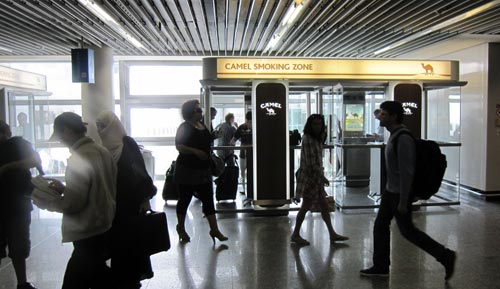
Frankfurt Airport again: This is something you’ll never see in a North American airport.
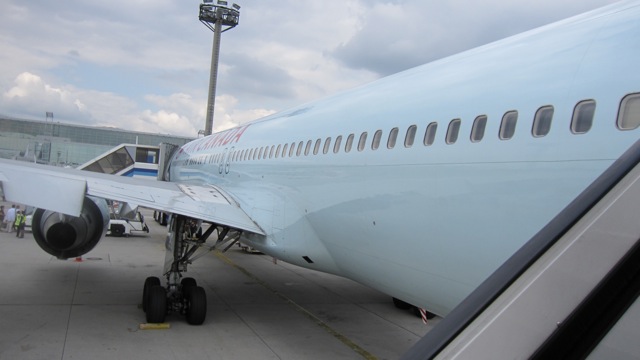
Bye Europe!! From halfway up the stairs off the Frankfurt airport tarmac. Direct terminal jetways are generally just for Lufthansa, from what we saw.
My impressions? Unlike Peter I’m still undecided about whether Prague or Vienna was my “favourite” city. Prague certainly had more “wow” in its sheer cheerful abundance of beautiful buildings—it’s no wonder Prague is the go-to city for period films. Adding to its charm, Prague still has a quirky personality—still rough around the edges; Vienna seems more polished (and monied), but therefore is more similar to other major world cities. But Vienna does have the advantage in being larger: If someone forced me to make a choice to visit either city again (poor me!), I think there would be more to further explore and do in Vienna (at the very least, the opportunity to see a multitude of operas!)
Final enormous thank-yous are again due to Grandpa S. and Nana Tara, and Grandma for enabling us to have an absolutely unforgettable experience!
More to come from other team PLJ members…
No comment yet
Jill says:
August 30, 2010 at 6:11 am (UTC 0)
Glad your first trip in 21 years was a success! Thanks for letting me travel vicariously through you!
hyedie says:
September 8, 2010 at 2:28 pm (UTC 0)
amazing!!!
that darwin exhibit is awesome – love you got that last message!! more people here need to see it! LOVE IT.